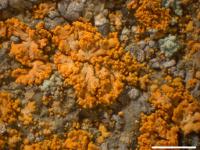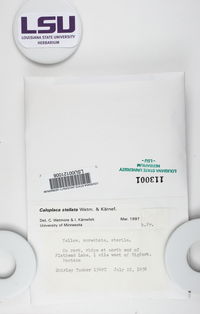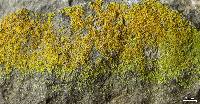
Consortium of Lichen Herbaria
- building a Global Consortium of Bryophytes and Lichens as keystones of cryptobiotic communities -
- Home
- Search
- Images
- Species Checklists
- US States: O-Z >
- US National Parks
- Central America
- South America
- US National Parks
- Southern Subpolar Region
|
|
|
|
Family: Teloschistaceae
[Caloplaca stellata Wetmore & Kaerneflt, moreMassjukiella stellata (Wetmore & Kärnefelt) S.Y. Kondr.] |
Nash, T.H., Ryan, B.D., Gries, C., Bungartz, F., (eds.) 2007. Lichen Flora of the Greater Sonoran Desert Region. Vol 3. Life habit: lichenized Thallus: crustose, elongate lobed, margin abrupt at edge, with elongated lobes 0.3-1.5 mm long, 0.1-0.2 mm wide; prothallus: absent surface: orange, smooth, sorediate soredia: fine, in irregular, marginal soralia on lobe tips cortex: cellular, 10-20 µm thick, granules absent; medulla dense, without granules Apothecia: rare, adnate or stipitate, 0.2-0.9 mm in diam., lecanorine disc: orange, flat or slightly concave, epruinose margin: persistent, slightly raised; thalline margin present, concolorous with thallus; proper margin not visible parathecium: elongate to oval cells; exciple below hypothecium cellular (paraplectenchymatous) epihymenium: golden, K+ red hymenium: hyaline, 60-70 µm tall paraphyses: 1-2 tip cells slightly swollen, not branched; subhymenium hyaline asci: cylindrical, 8-spored ascospores: hyaline, 2 locules, ellipsoid, 11-12.5(-14) x 5.5-7 µm, isthmus 3-4(-5.5) µm, spore end wall thin Pycnidia: present, mostly immersed, ostiole orange Spot tests: apothecial margin K+ red; thallus K+ red Secondary metabolites: unidentified anthraquinones. Substrate and ecology: on non-calcareous rocks World distribution: North America Sonoran distribution: southern California, Arizona, and Baja California. Notes: The most typical material of Caloplaca stellata looks star-shaped with its short radiating lobes. The lobes are usually narrow with granular soredia formed at the tips. Apothecia are very rare. Caloplaca pygmaea has no elongated lobes and the granular soredia develop from the lobe surface as well as the margins. Some forms of C. citrina and C. flavogranulosa are similar in appearance to C. stellata but they have areolate thalli and do not have radiating lobes. Caloplaca decipiens has much longer, broader, thicker and more convex lobes and the thallus is larger. |
Powered by Symbiota


































